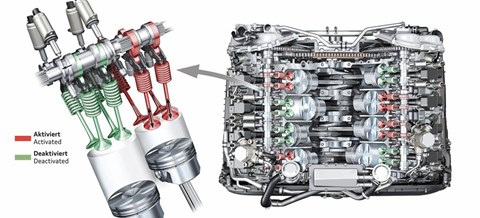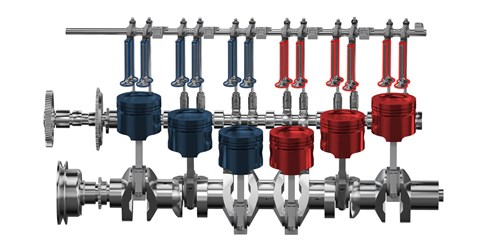► Shutting off cylinders to save fuel
► Shouldn’t be obvious when driving
► The tech is now widepsread
Car makers are continually developing new technologies to minimise fuel consumption and, in addition to clever turbocharging, direct injection and advanced valve timing, cylinder deactivation is another economy boosting trick.
Why should your car continue firing on all cylinders if maximum performance is not required? The result is wasted displacement, as fuel is pumped into a cylinder to extract power that isn’t necessarily needed.
Cylinder deactivation – also called variable displacement or cylinder on demand – has been around for quite some time but is becoming increasingly popular as manufacturers try to cut emissions as well as fuel use.

One of the best and simplest ways to make each drop of fuel go further is to make sure its not used at all! That’s the principle behind cylinder deactivation which temporarily switches off some cylinders of larger engines when under light load, and is controlled on the fly by the car’s engine control electronics.
The technology is mostly used in cars with 6-cylinder and 8-cylinder engines such as the Mercedes-AMG E63 S and Jeep Grand Cherokee SRT, but it’s also in use in Ford’s new Fiesta ST which goes from three cylinders to two on light throttle cruising as well as some of Audi’s small four-cylinder units.
Car makers employ different methods of initiating cylinder deactivation but essentially it involves freezing the valves that normally allow the flow of fuel and air into selected cylinders so the combustion process is only taking place in a smaller number of cylinders. It’s now effectively a much smaller engine.
This process is all cleverly controlled by the car’s computer systems which detects when you might need an extra burst of power, reactivating all cylinders for full power. The process is almost imperceptible and only way you’ll know it’s happening is typically through a light on the instrument cluster.

It’s a smart process that not so much increases fuel efficiency, rather it decreases fuel inefficiency.
Your driving style dictates how much of an effect it will have on your fuel economy. Drivers with a lead foot might not see much of an advantage but for those who potter about for extended drives, you may very well see a substantial reduction in fuel use.
Cylinder deactivation is just one of a number of ways car makers are reducing the impact on the environment and your back pocket.
This article originally appeared on whichcar.com.au